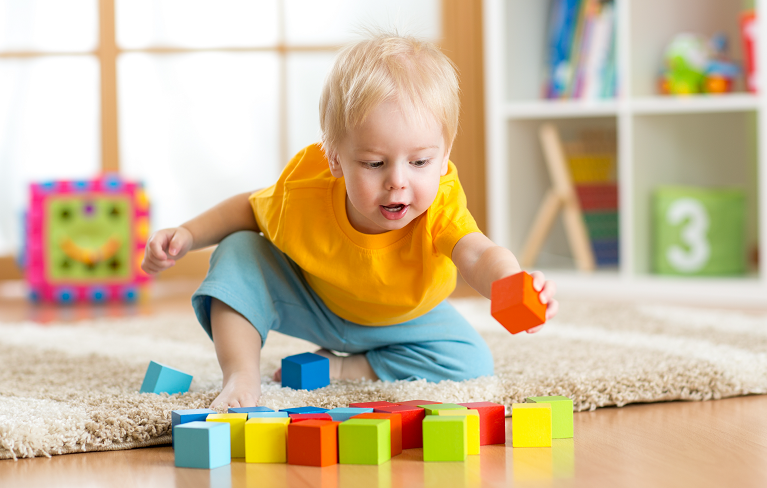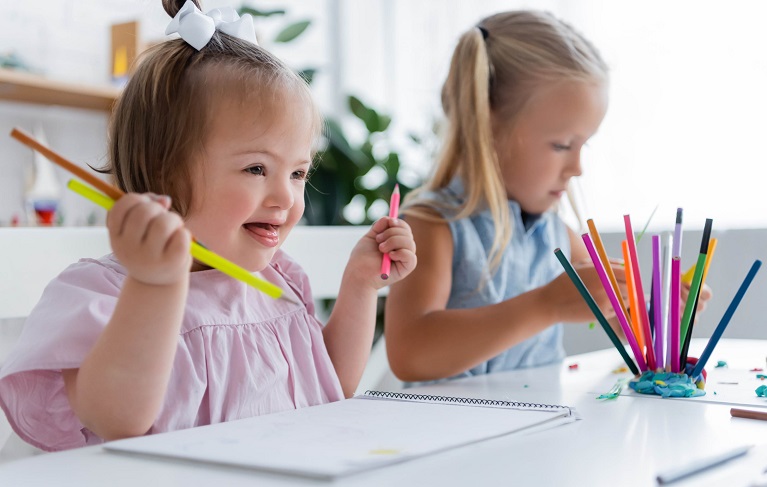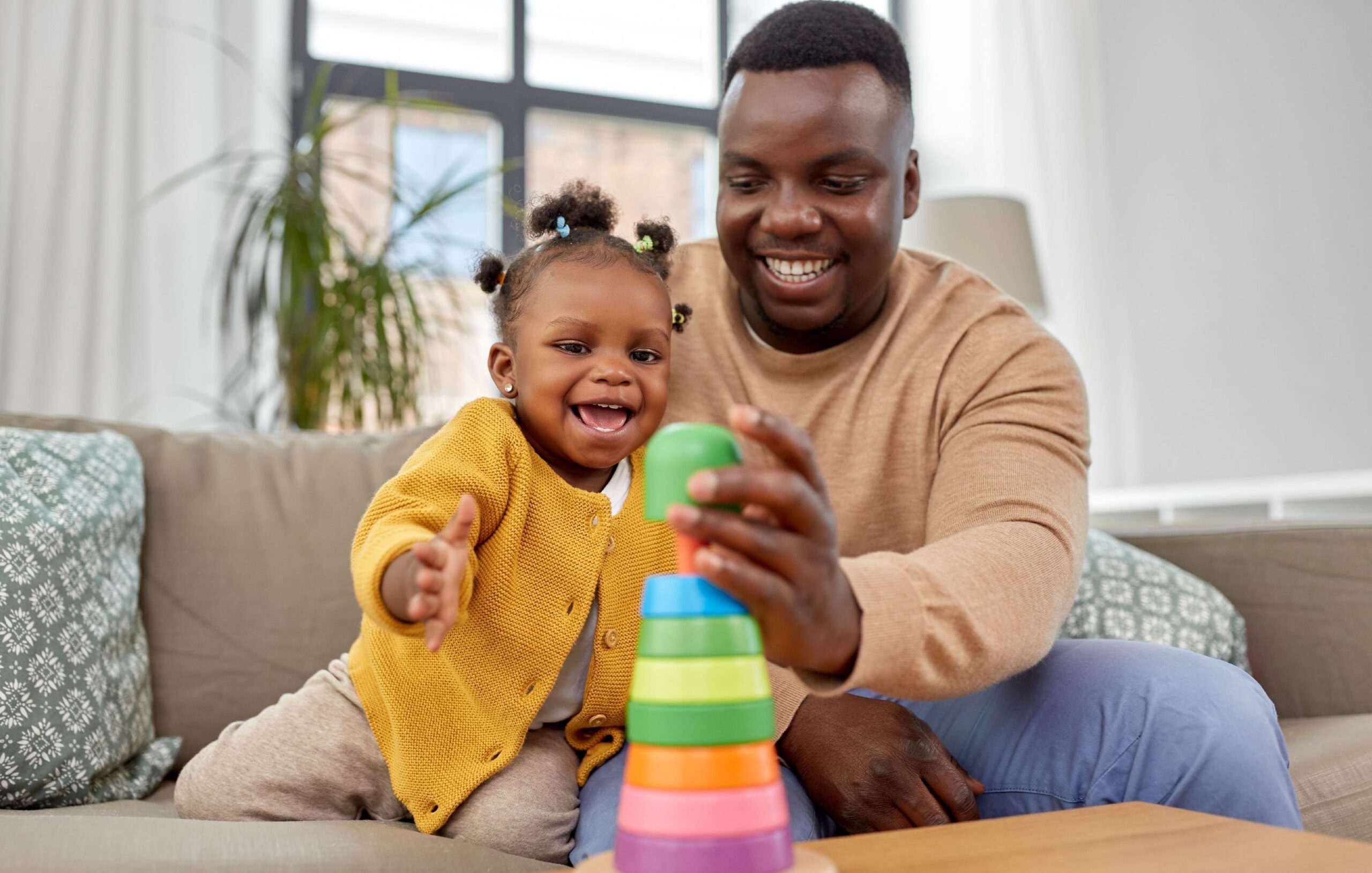Playful Ways to Support Fine Motor Skills
PublishedReaching, grasping, pointing, using both hands: these and other skills are building blocks of fine motor development in young children. The tips in today’s post—excerpted and adapted from Early Intervention Every Day by Merle J. Crawford and Barbara Weber—are great for sharing with parents and other caregivers to help them teach these skills to young children during daily routines at home.
Batting and Reaching
Batting and reaching help develop eye–hand coordination and are often some of the first movements that begin the process of learning about cause and effect. Here are a few ways caregivers can support batting and reaching during daily routines:
- Diapering and Dressing: Place a clean diaper or clothing item above the child’s eyes to bat away to play Peekaboo. Tickle or rub the child’s arm or hand and then stop with your hand near the child’s. When the child reaches and touches your hand, begin again.
- Mealtime/Snack Time: Playfully encourage the child to reach for the bottle or the cup as well as snack foods.
- Playtime: Place toys that make sounds within the child’s reach when the child is on the floor.
- Bath Time: Hold out toys for the child to bat at so they will fall in the water and splash.
- Bedtime: Present books, your face, and bedtime comfort objects nearby for a child to touch.
Grasping
Grasping is important for the development of play skills, thinking skills, and self-care skills such as eating, dressing, grooming, and practicing hygiene. Caregivers can support grasping skills in many ways:
- Diapering and Dressing: Have the child reach for your hands, a diaper, or a toy after diaper changes.
- Mealtime/Snack Time: Gently help the child hold the feeder’s fingers during bottle or breast feeding. For babies who take a bottle, encourage them to hold the bottle by gently and playfully taking their hands to the bottle. As the child begins to finger feed, place soft pieces of food on their tray.
- Playtime: Provide a variety of shapes and sizes of toys for the child to hold, starting with lightweight and thin rattles and rings, and progress to heavier and more varied shapes.
- Bath Time: Provide sponges, washcloths, empty small plastic bottles, and toys such as rubber duckies for the child to grasp.
Transferring from Hand to Hand
Very young children often practice transferring from one hand to another as they explore an object. Transferring helps a child refine grasping, releasing, and coordinated use of two hands. Here’s how parents can support transferring skills during daily routines:
- Diapering and Dressing: Have the child hold a relatively small toy (but not so small that it is a choking hazard). When it is time to push the child’s hand through a sleeve, help the child move the toy to their other hand.
- Mealtime/Snack Time: Give the child two food items, presented one at a time to the same hand to facilitate a transfer. Present both items to the right hand and then later to the left, or vice versa.
- Playtime: Place a bowl, basket, or box of easily held toys in front of the child. At times place the container near the right hand and at other times, near the left hand. As the child takes them out, they may move the items to the other hand.
Releasing
A child must learn to actively release objects in order to be successful with many activities, such as handing items to others, self-feeding, and putting items away. Here are some tips for supporting releasing skills:
- Diapering and Dressing: Ask the child to hand you the diaper, wipes, lotion, and other types of supplies to help with release. At first it may be necessary to gently tug to help the child release, but over time the child will be able to drop the item into a waiting hand.
- Mealtime/Snack Time: Give the child small pieces of finger food to practice releasing into the mouth. As a child gains more of a skilled release, provide containers first with large openings and then progress to smaller openings to put the food into.
- Playtime: Provide a variety of containers to practice release. Children often love to put things into holes and slots.
- Bath Time: Provide plastic tub toys, cups, and bowls to make bath time fun and facilitate practice of release.
Using Both Hands
Many activities that children and adults perform require skilled use of both hands. Use these tips to support using both hands during daily routines:
- Diapering and Dressing: Children can hold a diaper in one hand and the tube of cream in the other to assist in the diapering process. For children who are ready to assist with dressing and undressing, have them help pull their shoes and socks on and off and pull their shirts and pants on and off. The child can help zip and button when they are proficient at easier dressing tasks.
- Playtime: Place socks, rattles, and other toys in both of the child’s hands. For children who no longer put items in their mouths, have them put tape or stickers on a paper towel tube and bits of cereal in an empty bottle. Sing songs with hand motions such as “Itsy Bitsy Spider” to encourage two-hand use.
- Mealtime/Snack Time: Provide sippy cups with two handles to encourage the use of both hands. When children are beginning to use a spoon to self-feed, help them hold the bowl/plate with one hand while they scoop with the other. When giving the child snacks such as cookies or crackers, give two items, one for each hand.
- Bath Time: Show the child how to splash with both hands. Have the child hold small bath toys in each hand. When the child is ready to help with bathing, ask them to hold the washcloth and help put on the soap.
- Book Time: When looking at a book, have the child hold the book with one hand and turn the pages with the other.
Poking and Pointing
Isolating the index finger to poke and point helps develop motor coordination, and pointing is also an important component of communication. Here are some ideas for supporting poking and pointing skills:
- Mealtime/Snack Time: Give the child a small container or a cleaned foam egg carton with bits of cereal or other finger food in them. Encourage the child to use their index finger to scoop out the food. Hold out choices of food or drink for the child to point to.
- Playtime: Provide empty containers such as plastic bottles with relatively narrow openings and playfully help the child isolate their index finger and place it into the opening, making a silly noise. Provide pudding or ketchup for finger painting and show the child how to draw with the index finger. Ask the child to point to your nose, playfully saying “beep-beep” to motivate the child to do this again.
- Book Time: Ask the child to point to pictures you name and pictures they want you to talk about.
- Bath Time: Have the child point to the body part to wash next.
Taking Apart and Putting Together
Children develop eye–hand coordination, visual-perceptual skills, and understanding of size relationships by taking objects apart and figuring out how to put them back together again.
How to support taking apart and putting back together during daily routines:
- Mealtime/Snack Time: During meal preparation, sit the child at the table, in a highchair, or in a booster seat. They can help open and close lids of containers you need for the meal—for example, they can take the lid off the butter or margarine tub and put it back on when you’re done. Have the child put lids on a variety of bottles, plastic storage containers, and other similar items.
- Playtime: Provide various sizes of plastic containers with lids and shoeboxes with tops for children to play with. Select toys that go together easily, such as those with hook and loop fasteners, and progress to toys that easily slide together and then to toys that snap together. Provide the child with nesting bowls, measuring cups, and boxes to fit one inside the other.
With the suggestions in this post, it’s easy to create varied learning experiences that help young children develop essential fine motor skills. Share this post with parents to help them strengthen their child’s skills while enjoying everyday routines together.
P.S. Activities should be supervised at all times by an adult. Any material, food, or toy given to a young child should be reviewed for safety.



